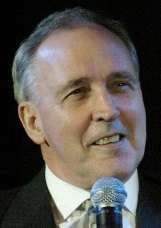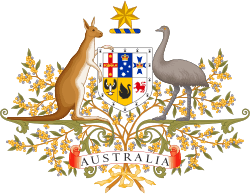Australian federal election, 1996
| | |||||||||||||||||||||||||||||||||||||||||||||||
| |||||||||||||||||||||||||||||||||||||||||||||||
| |||||||||||||||||||||||||||||||||||||||||||||||
| |||||||||||||||||||||||||||||||||||||||||||||||
Federal elections were held in Australia on 2 March 1996. All 148 seats in the House of Representatives and 40 seats in the 76-member Senate were up for election. The incumbent Australian Labor Party, in government for 5 terms totaling 13 years, led by Bob Hawke (1983–1991) and Paul Keating (1991–1996), was defeated by the opposition Liberal Party of Australia led by John Howard and Coalition partner the National Party of Australia led by Tim Fischer.
Result
| Party | Votes | % | Swing | Seats | Change | |||
|---|---|---|---|---|---|---|---|---|
| Australian Labor Party | 4,217,765 | 38.75 | −6.17 | 49 | −31 | |||
| Liberal Party of Australia | 4,210,689 | 38.69 | +1.92 | 75 | +26 | |||
| National Party of Australia | 893,170 | 8.21 | +1.04 | 18 | +2 | |||
| Australian Democrats | 735,848 | 6.76 | +3.01 | 0 | 0 | |||
| Australian Greens (NSW, Qld, SA, ACT, NT) | 188,994 | 1.74 | +0.82 | 0 | 0 | |||
| Australians Against Further Immigration | 73,023 | 0.67 | +0.64 | 0 | 0 | |||
| Greens Western Australia | 53,101 | 0.49 | −0.04 | 0 | 0 | |||
| Australian Greens Victoria | 52,810 | 0.49 | +0.46 | 0 | 0 | |||
| Call to Australia | 43,183 | 0.40 | −0.08 | 0 | 0 | |||
| Natural Law Party | 41,573 | 0.38 | −0.36 | 0 | 0 | |||
| Country Liberal Party | 38,302 | 0.35 | +0.02 | 1 | +1 | |||
| Tasmanian Greens | 19,689 | 0.18 | −0.05 | 0 | 0 | |||
| No Aircraft Noise | 18,626 | 0.17 | * | 0 | 0 | |||
| Australia's Indigenous Peoples Party | 12,507 | 0.11 | +0.08 | 0 | 0 | |||
| Reclaim Australia: Reduce Immigration | 6,457 | 0.06 | * | 0 | 0 | |||
| Australian Women's Party | 6,173 | 0.06 | * | 0 | 0 | |||
| One Australia Party | 3,159 | 0.03 | * | 0 | 0 | |||
| Grey Power | 2,815 | 0.03 | +0.01 | 0 | 0 | |||
| Australia's Christian Heritage | 2,722 | 0.03 | * | 0 | 0 | |||
| Central Coast Green Party | 1,887 | 0.02 | +0.00 | 0 | 0 | |||
| Richmond/Clarence Greens | 1,173 | 0.01 | −0.01 | 0 | 0 | |||
| Pensioner & CIR Alliance | 332 | 0.00 | * | 0 | 0 | |||
| Republican Party of Australia | 156 | 0.00 | * | 0 | 0 | |||
| Independents | 247,016 | 2.27 | −0.98 | 5 | +3 | |||
| Not Affiliated | 12,945 | 0.12 | 0 | 0 | ||||
| Total | 10,883,852 | 148 | +1 | |||||
| Two-party-preferred vote | ||||||||
| Liberal/National coalition | WIN | 53.63 | +5.07 | 94 | +29 | |||
| Australian Labor Party | 46.37 | −5.07 | 49 | −31 | ||||
Independents: Peter Andren, Pauline Hanson, Allan Rocher, Graeme Campbell, Paul Filing (ex-Liberal)
| Party | Votes | % | Swing | Seats Won | Seats Held | |
|---|---|---|---|---|---|---|
| Australian Labor Party | 3,940,150 | 36.15 | −7.35 | 14 | 29 | |
| Liberal/National (Joint Ticket) | 2,669,377 | 24.49 | +0.09 | 6 | ||
| Liberal Party of Australia | 1,770,486 | 16.24 | +0.65 | 12 | 31 | |
| Australian Democrats | 1,179,357 | 10.82 | +5.51 | 5 | 7 | |
| National Party of Australia | 312,769 | 2.87 | +0.15 | 1 | 5 | |
| Australian Greens (NSW, Qld, SA, ACT, NT) | 180,404 | 1.66 | −0.28 | 0 | 0 | |
| Australians Against Further Immigration | 137,604 | 1.26 | +0.82 | 0 | 0 | |
| Call to Australia | 117,274 | 1.08 | +0.25 | 0 | 0 | |
| Australian Shooters Party | 114,724 | 1.05 | +0.45 | 0 | 0 | |
| Australian Greens Victoria | 81,273 | 0.74 | +0.44 | 0 | 0 | |
| WA Greens | 57,006 | 0.52 | +0.02 | 0 | 1 | |
| Australian Women's Party | 49,131 | 0.45 | * | 0 | 0 | |
| Reclaim Australia: Reduce Immigration | 44,545 | 0.41 | * | 0 | 0 | |
| Country Liberal Party | 40,050 | 0.37 | +0.04 | 1 | 1 | |
| Democratic Labor Party | 36,156 | 0.33 | −0.03 | 0 | 0 | |
| Tasmanian Greens | 26,830 | 0.25 | * | 1 | 1 | |
| A Better Future for Our Children | 18,960 | 0.17 | * | 0 | 0 | |
| Natural Law Party | 17,082 | 0.16 | −0.20 | 0 | 0 | |
| No Aircraft Noise | 17,043 | 0.16 | −0.20 | 0 | 0 | |
| Grey Power | 13,401 | 0.12 | −0.04 | 0 | 0 | |
| Pensioner & CIR Alliance | 9,040 | 0.08 | −0.13 | 0 | 0 | |
| The Seniors | 8,268 | 0.08 | * | 0 | 0 | |
| Republican Party of Australia | 7,778 | 0.07 | −0.06 | 0 | 0 | |
| One Australia Party | 3,638 | 0.03 | * | 0 | 0 | |
| Australia's Indigenous Peoples Party | 2,772 | 0.03 | −0.03 | 0 | 0 | |
| Independent EFF | 2,430 | 0.02 | * | 0 | 0 | |
| Harradine Group | * | * | −0.30 | 0 | 1 | |
| Other | 41,489 | 0.38 | −0.23 | 0 | 0 | |
| Total | 10,899,037 | 40 | 76 | |||
Independents: Mal Colston (resigned from ALP in August 1996)
House of Reps preference flows
- The Democrats contested 138 electorates with preferences slightly favouring Labor (54.02%)
- The Greens contested 102 electorates with preferences favouring Labor (67.10%)
Seats changing hands
- *Figure is Liberal against Nationals.
- **Figure is a swing compared to Liberal vote at the last election.
Background
Overall the coalition won 29 seats from Labor while the ALP won 4 seats from the Liberals. These 4 seats were Canberra and Namadgi in the ACT and Isaacs in Victoria and the Division of Bruce in Victoria. The ACT seats fell to Labor due to a strong return to the ALP in a traditional Labor town by public servants fearing conservative cuts. The division of Brendan Smyth's seat of Canberra into the two new (of the three) ACT seats limited his campaign to the southernmost Tuggeranong seat of Namadgi where the ACT Labor right wing stood former MLA Annette Ellis who ran a tight grassroots campaign. Isaacs fell to Labor due to demographic changes due to a redistribution of electoral boundaries.

John Howard, who had previously led the Liberal Party from 1985 to 1989, had returned to the leadership in January 1995 following a disastrous 8 months under the leadership of Alexander Downer. Downer and Peter Costello had succeeded Dr. John Hewson and Michael Wooldridge early in 1994 and were touted as the leaders of the new-generation Liberals. In the end, the party opted for the seasoned Howard, perhaps an acknowledgment that he was the only one left standing after a decade of party infighting.
Howard approached the campaign with a determination to present as small a target as possible. Throughout 1995, he refused to detail specific policy proposals, focusing the Coalition's attacks mainly on the longevity and governing record of the Labor government. By 1996, however, it was clear that the electorate had tired of Labor and Paul Keating in particular. "The recession we had to have" line resonated with deadly force throughout the electorate. Although Keating's big picture approach to republicanism, reconciliation and engagement with Asia galvanised support within Labor's urban constituencies, Howard was able to attract support amongst disaffected mainstream Australians – including traditionally Labor-voting blue collar workers and middle class suburban residents. He also promised to retain Medicare and hold a constitutional convention to decide whether Australia would become a republic.
The election-eve Newspoll reported the Liberal/National Coalition on a 53.5 percent two-party-preferred vote.[1]
Labor lost five percent of its two-party vote from 1993, and tallied its lowest primary vote since 1934 (an additional eight percent coming from preferences). The swing against Labor was not in and of itself enough to cause a change of government. However, Labor lost 13 of its 33 seats in New South Wales, and all but two of its 13 seats in Queensland. The 29-seat swing was the second-largest defeat, in terms of seats lost, by a sitting government in Australia. Three members of Keating's government—including Attorney-General Michael Lavarch —lost their seats. Keating resigned as Labor leader on the night of the election, and was succeeded by former Deputy Prime Minister and Finance Minister Kim Beazley.
Due in part to this large swing, Howard entered office with a 45-seat majority, the second-largest in Australian history (behind only the 55-seat majority won by Malcolm Fraser in 1975). The Liberals actually won a majority in their own right at this election with 75 seats, the most the party had ever won. Although Howard had no need for the support of the Nationals, the Coalition was retained.
See also
- Candidates of the Australian federal election, 1996
- Members of the Australian House of Representatives, 1996–1998
- Members of the Australian Senate, 1996–1999
References
- ↑ "Newspoll archive since 1987". Polling.newspoll.com.au.tmp.anchor.net.au. Retrieved 2016-07-30.
External links
- Australian Electoral Commission Results
- University of WA election results in Australia since 1890
- AEC 2PP vote
- AustralianPolitics.com election details
- Preference flows – ABC

